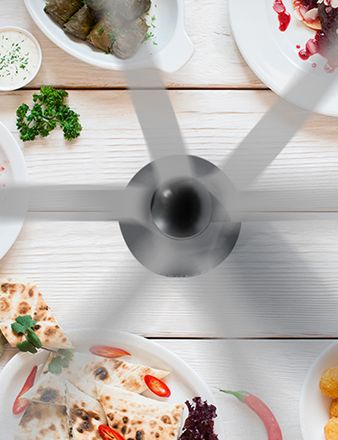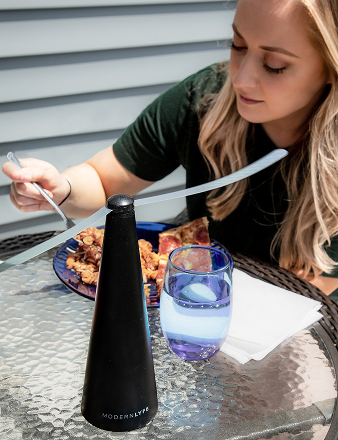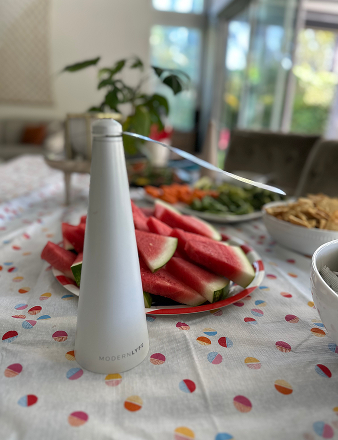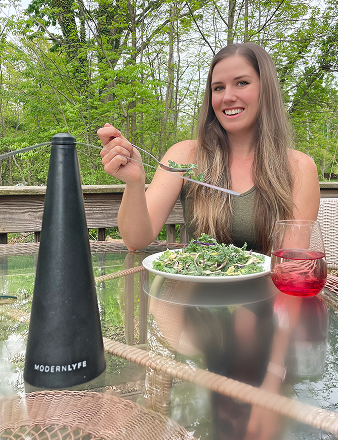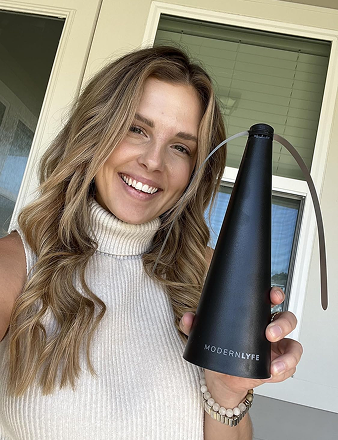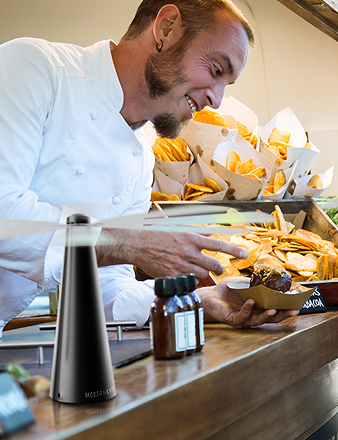Nothing ruins an outdoor meal faster than a swarm of flies. You've grilled the perfect steaks, mixed a beautiful salad, and just as everyone sits down, the buzzing begins. It's a classic summer frustration, but it doesn't have to be your reality.
Keeping your patio feast fly-free isn't about one magic trick. It's about a smart, layered strategy. Think of it as creating a "no-fly zone" by making your dining area completely unappealing to them.
This guide will walk you through the entire playbook, from simple cleanup hacks and natural deterrents to clever, chemical-free tech. The goal is to create a space where flies simply don't want to be, letting you enjoy your food in peace.
First, Think Like a Fly
To beat flies, you have to understand them. They're driven by simple instincts: they're constantly hunting for food, water, and a place to lay eggs. Your best defense is to remove those temptations before they even arrive.
Get a handle on the three biggest things that bring flies flocking to your yard.
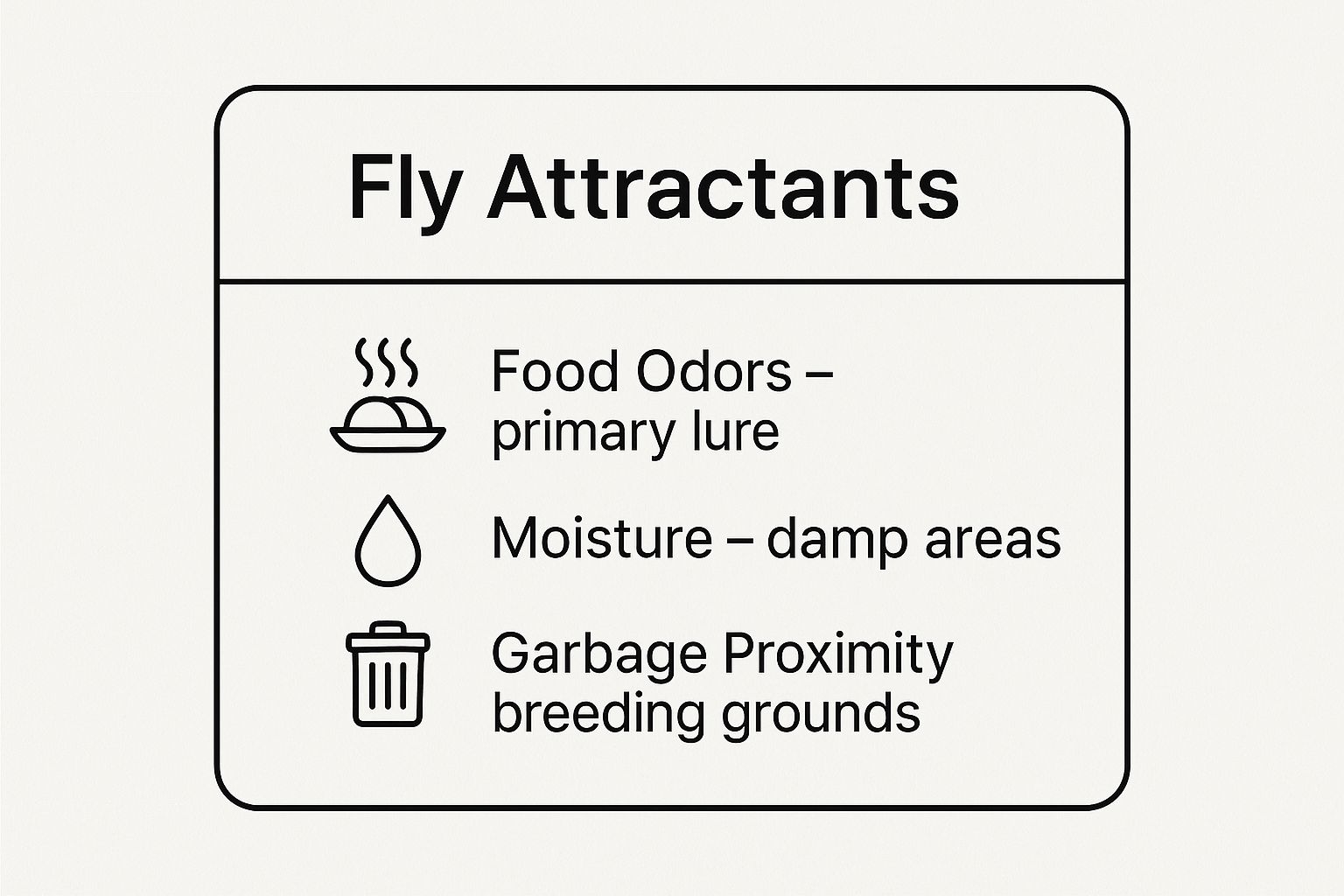
It all boils down to food smells, moisture, and garbage. If you can control these three elements, you’ve already won half the battle.
The best fly control starts before you see a single fly. By removing their main draws—food, water, and breeding spots—you make your space an undesirable stop from the start.
No single method is foolproof, which is why a layered defense is the key to success.
Here's how to combine tactics for maximum effect:
- Be Tidy: Don't let spills sit. Wipe them up immediately. Keep trash cans tightly lidded and, if possible, move them far from where you're eating.
- Location Matters: When setting up your table, be mindful of what's nearby. Avoid placing it right next to a compost pile, stagnant water, or dense bushes where flies love to rest.
- Create Invisible Barriers: A simple fan creates enough of a breeze to keep lightweight flies from landing. You can also use the natural scents of certain herbs to make the area less appealing to them.
By using a few of these tactics together, you build a much stronger defense and can finally reclaim your outdoor meals.
To make it even easier, here's a quick summary of the core strategies we'll cover.
Fly Prevention Quick Reference Guide
| Strategy Category | Key Actions | Why It Works |
|---|---|---|
| Sanitation & Cleanup | Immediately clean spills, keep trash sealed, and manage pet waste. | Removes the food sources and breeding grounds that attract flies in the first place. |
| Food & Table Placement | Set up dining areas away from compost, garbage, or standing water. | Increases the distance between flies' favorite hangouts and your meal. |
| Environmental Controls | Use fans for airflow; plant herbs like mint, basil, and lavender. | Creates physical and scent-based barriers that flies find difficult or unpleasant to cross. |
| Physical Barriers | Use food covers, mesh tents, or lidded containers for dishes. | Directly blocks flies from being able to land on or touch the food. |
| Modern Technology | Deploy devices like the Modern Lyfe Fly Fan around the table. | The spinning blades create a disorienting visual and gentle air current that repels flies without chemicals. |
Keep these core ideas in mind as we dive deeper. You’ll find that a little proactive effort goes a long way in keeping your outdoor dining experience pleasant and pest-free.
Build Your First Line of Defense with Sanitation
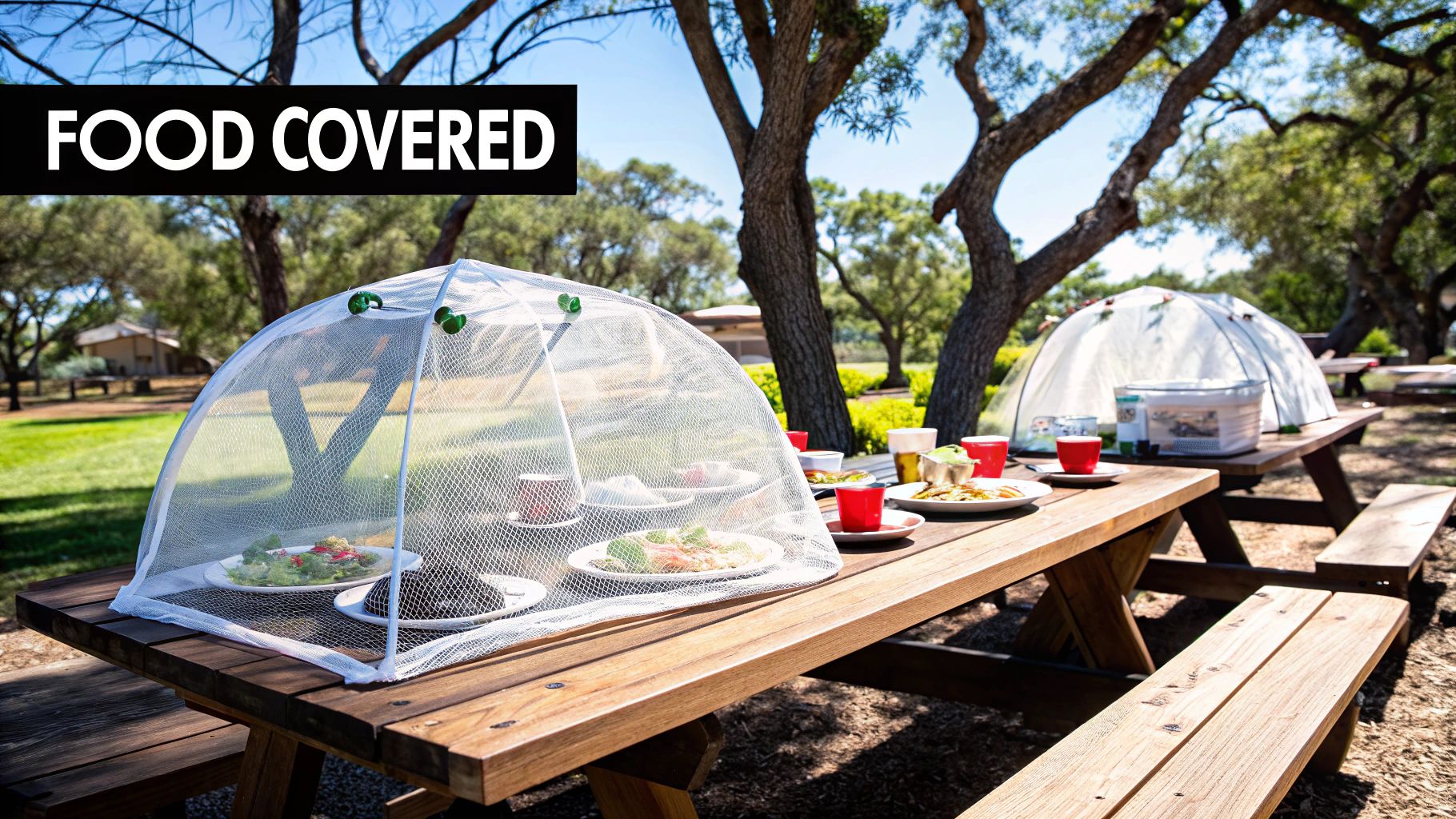
If you want to keep flies away from your food outside, your first move is to make your dining area completely unappealing to them before you bring out the food. This is more than a quick wipe-down. It’s about proactively removing everything that might attract a fly.
From a fly's perspective, a sticky spill or a few crumbs are a giant welcome sign. Your goal is to turn your patio into a "no-fly zone" by eliminating those invitations.
Master Your Trash Management
Let's be direct: your garbage can is the biggest fly magnet in your yard. A simple lid isn't enough, especially if it’s dirty or sitting right next to your picnic table. You have to be strategic.
Here’s how to turn that trash can from a fly buffet into a non-issue:
- Create Distance: The simplest, most effective trick is to move your garbage and recycling bins at least 15-20 feet away from where you eat. This small change makes a huge difference.
- Bag and Seal: Never toss loose food scraps into the bin. Always use a sturdy trash bag and tie it tightly to lock in odors.
- Wash It Out: During warmer months, scrub your outdoor trash can with soap and water at least once a month. This eliminates the sticky, smelly residue that flies love.
Proactively managing your trash cuts off the main source drawing flies to your yard.
Eliminate Hidden Fly Havens
Flies aren't just drawn to the obvious trash can. They're also on the lookout for less noticeable sources of food and moisture—the small things we often forget.
A piece of fruit that fell under a deck chair, a small puddle from a leaky hose, or even condensation from a cold drink can be enough to attract them. Fruit flies, in particular, are always searching for moisture and fermenting sugars. By getting rid of these spots, you break their life cycle and reduce the risk of an infestation.
Before any outdoor meal, do a quick five-minute patrol of your space. Hunt down and eliminate any potential food sources or standing water. It's one of the most powerful fly repellents there is, and it costs nothing.
Your Pre-Meal Sanitation Checklist
Make a quick sanitation sweep a habit before you eat outside. It will become your best defense against buzzing party crashers.
- Wipe Down Surfaces: Use a cleaner to give your table, chairs, and any nearby ledges a thorough wipe. Remove any old, sticky residue from past meals.
- Scan for Spills and Crumbs: Check the ground under and around your table. It’s easy to miss dropped food.
- Check for Standing Water: Empty the saucers under potted plants and check for any puddles on the patio or rainwater collected in toys.
- Manage Pet Areas: If you have pets, ensure their waste is cleaned up. It's also smart to move their food and water bowls away from your dining area.
This detailed cleaning sends a clear message to flies: there’s nothing for you here. To dive deeper into other effective strategies, take a look at our complete guide on how to keep flies away from food. Getting your sanitation right is the foundation that makes every other tactic work even better.
Create a No-Fly Zone with Natural Scents and Airflow

Beyond cleaning, you can build a defensive perimeter that flies hate but your guests will love. Using natural scents and a steady breeze is one of the most effective, low-effort ways to protect your outdoor meal. It’s a simple, chemical-free strategy to tell flies they aren't invited.
The idea is to use plants, essential oils, and wind to create a protected bubble around your dining area. You’re not just keeping flies away; you’re adding pleasant aromas and style to your space.
Let Aromatic Plants Do the Work
Some plants are beautiful, smell fantastic, and happen to be excellent fly repellents. Their strong aromatic compounds are overwhelming for flies, who will steer clear of any area where these scents are present.
Adding a few potted herbs to your patio is a solution that’s as functional as it is beautiful.
- Basil: A key ingredient for a great caprese salad, basil also works overtime keeping flies out. A few small pots on the dining table can act as a fragrant, edible centerpiece.
- Mint: The sharp, refreshing scent of mint is another powerful deterrent. A pot of spearmint or peppermint near your table can make a real difference.
- Lavender: We find its floral scent relaxing, but flies can't stand it. Place a few lavender plants around the edge of your patio or deck.
- Rosemary: This rugged herb doesn't just smell incredible when you’re grilling; it helps keep pests away with its potent aroma.
Placing these plants around your space creates an invisible shield, making your table a much less attractive target.
Mix a DIY Essential Oil Spray
Don't have a green thumb? No problem. Essential oils deliver the same fly-repelling power in a simple spray. Mixing your own repellent is easy, safe to use around food, and skips the harsh chemicals in commercial bug sprays.
Just grab a spray bottle and add about 10-15 drops of your chosen essential oil to a cup of water. Shake well before each use and lightly mist the air around your table, the tablecloth, and even the chair legs.
A homemade spray with peppermint or eucalyptus oil is my personal go-to. It smells incredibly clean and refreshing, and I've found that flies genuinely avoid it. It’s a quick, cheap trick that works instantly.
Some of the best oils for the job are:
- Peppermint
- Eucalyptus
- Lemongrass
- Clove
This is a great way to get a quick burst of repellent right where you need it, especially just as everyone is sitting down to eat.
Make the Wind Your Ally
One of the simplest and most effective tactics is also the most overlooked: a steady breeze. Flies are terrible fliers. They are small and light, so any consistent airflow makes it nearly impossible for them to navigate, let alone land on your food.
A portable, battery-operated fan placed on or near the table is a game-changer. Just point it to blow a gentle breeze across the food. This creates an invisible dome of moving air that flies can't penetrate, keeping your meal untouched.
Use Smart Food Placement and Protective Covers

Even after cleaning the deck and lighting the herbs, the aroma of your barbecue is an open invitation for every fly in the neighborhood. This is where you have to get smart about how you set out and protect the food itself. A few simple, physical barriers make all the difference.
The less time your food sits out in the open, the less chance flies have to find it. Instead of laying out a huge spread an hour before anyone eats, focus on covering dishes and bringing them out at the right moment.
Choose the Right Protective Gear
Physical barriers are your best bet for keeping flies directly off the food. You want something that works for your setup while still letting guests see the delicious options.
Here are a few go-to choices:
- Mesh Food Domes: A classic for a reason. They're lightweight, collapsible for easy storage, and perfect for covering a plate of burgers or a bowl of salad right on the table.
- Lidded Serving Dishes: Anything creamy or saucy—like potato salad, coleslaw, or baked beans—should be in a serving bowl with a solid, tight-fitting lid. Keep it on until people are ready to serve themselves.
- Insulated Food Carriers: If you're bringing a dish to a potluck or just moving it from the kitchen to the patio, these carriers are fantastic. They keep hot food hot and cold food cold, and they seal everything away from pests during transit.
Having a few of these on hand makes outdoor dining far less stressful. They are a simple, impenetrable shield against flies.
Master Your Serving Timing
This might sound obvious, but when you bring food out is a massive factor. The longer a dish sits uncovered, the more time its scent has to travel on the breeze and attract flies. A small tweak to the serving schedule can solve the problem.
I swear by the "just-in-time" serving method. Don't bring everything out at once. Keep dishes in the kitchen until guests are actually lining up with their plates. This gives flies a tiny window to even notice the food is there.
As a bonus, your food stays fresher and at the right temperature for longer.
Implement the Buffet Strategy
For bigger parties, the "buffet strategy" is your secret weapon. The idea is to set up the main food station in a protected area, giving you total control.
It’s all about creating a fly-free zone for the main event: serving.
- Set Up Just Inside: A great trick is to use the kitchen island or a dining table right inside the back door as the buffet line. Guests can fill their plates in a completely bug-free space and then walk outside to find a seat.
- Use a Screened-In Porch: If you're lucky enough to have a screened-in porch, that's the perfect spot. It keeps the food protected while still making everyone feel like they're part of the outdoor gathering.
This simple change contains the strongest food smells and drastically cuts down on the time that open plates are outside. You'll notice a huge reduction in the number of flies buzzing around your guests.
Bring in the Modern Lyfe Fly Fan
While cleaning and natural repellents are great first steps, sometimes you need a reliable, set-it-and-forget-it solution. This is where a good fly fan completely changes the game. It’s a simple, chemical-free way to keep flies from ever landing on your food.
Instead of messing with sprays or scents, fly fans work on a brilliantly simple principle: disorientation. They create an invisible, protective dome over your food by disrupting the two things flies rely on most—their sight and the need for calm air.
How Spinning Blades Keep Flies Away
The secret to a fly fan is its soft, reflective blades. As they spin, they catch and scatter light, creating a confusing, shimmering visual pattern that a fly's compound eyes can't process. To a fly, this constant, unpredictable movement looks like a threat, and their survival instinct tells them to stay away.
At the same time, the rotating blades produce a gentle but consistent breeze directly over your food. Flies are notoriously weak fliers and have a tough time navigating even a mild air current. This one-two punch of visual confusion and air disturbance creates an invisible barrier they simply won't cross.
The best part? You and your guests won't even notice it. You get a protected, fly-free zone without any noise, smells, or chemicals. If you want to dive deeper into the science, we have a whole article explaining how fly fans work.
Why Fly Fans Are a Must-Have
Choosing a fly fan isn't just about effectiveness; it’s about convenience and safety. These devices are designed to make your life easier.
- Completely Chemical-Free: No sprays, fumes, or weird smells. This makes them perfectly safe to use right next to your food and a great choice for families with kids and pets.
- Safe-Stop Blades: The blades are soft and flexible. If a hand reaches for a burger and gets in the way, the blades immediately stop spinning. No nicks, no cuts.
- Totally Portable: Modern fly fans are battery-powered, so you can place them anywhere without hunting for an outlet. Perfect for picnics, camping, or the far corner of the patio.
The real beauty of a fly fan is its simplicity. You just turn it on, place it on the table, and your fly problem is solved for the rest of the meal. It’s a silent, odorless guardian for your food.
This hands-off approach is so effective that it's used by professionals. Restaurants and outdoor food vendors are in a constant battle with pests, since even the cleanest spot can't hide the lure of food. It's a huge issue—more than 50% of restaurants in North America report problems with fruit flies alone, highlighting the need for continuous control. If you're curious, you can learn more about how professional venues manage pests at theflylady.com.au.
Smart Placement for Total Coverage
To get the most out of your fly fans, be strategic about where you put them. The goal is to create overlapping zones of protection that cover your entire spread.
For a typical round or square dining table, placing one or two fans in the center usually does the trick, protecting everyone's plates.
If you're setting up a long buffet table, a good rule of thumb is to place one fan every 2-3 feet. This ensures that from the potato salad at one end to the brownies at the other, your entire meal is shielded under a fly-free dome. You and your guests can finally relax and enjoy the food without that constant, annoying swatting.
Answering Your Top Questions About Outdoor Fly Control
Even with the best plan, a few questions always pop up when it comes to keeping flies away. Here are the most common ones, answered directly.
Getting these details right separates a peaceful meal from a constant swatting match.
Do Citronella Candles Actually Work on Flies?
The honest answer is: not really.
Citronella is known for repelling mosquitoes, but its effect on houseflies is minimal at best. The smoke might bother a fly that gets very close, but it won’t protect an entire picnic table. You’re much better off using something that creates a physical or air barrier, like a food tent or a quality fly fan.
Think of citronella as a supporting actor for mosquito control, not the main star of your fly defense.
What’s the Single Best Thing I Can Do to Stop Flies?
If you only do one thing, make it this: sanitation. I can't stress this enough. Flies are biologically hardwired to sniff out food, garbage, and decaying organic matter. If you take away the smells they're hunting for, you take away their reason for showing up.
This means wiping up spills the second they happen and ensuring your garbage cans have tight-fitting lids and are kept far from your eating area. And, of course, never leave food uncovered.
A clean, scent-free space is your ultimate weapon. Before you even think about repellents or traps, a quick five-minute sweep of the area to remove attractants will have a bigger impact than anything else.
Are Bug Zappers a Good Choice for Eating Areas?
Bug zappers are a terrible choice for anywhere near food. That loud, startling ZAP! is not only disruptive, but it can also splatter tiny insect particles into the air and onto your table. It’s not a hygienic solution for a dining space.
Plus, zappers are indiscriminate. They kill all sorts of bugs, including beneficial insects we want to keep around. For protecting your meal, a targeted and clean approach like a fly fan is a much smarter move. For a deeper dive into other methods, check out our guide on how to keep flies away outside.
By focusing on prevention through cleanliness and using smart, targeted tools, you can create the perfect, buzz-free zone for you and your guests to enjoy.
Ready to reclaim your outdoor meals with a simple, effective, and chemical-free solution? The MODERN LYFE fly fan is designed to create a protected, pest-free zone around your food, so you can finally relax and enjoy your time outside. Visit https://modernlyfe.com to see how our fans can transform your outdoor dining experience.

